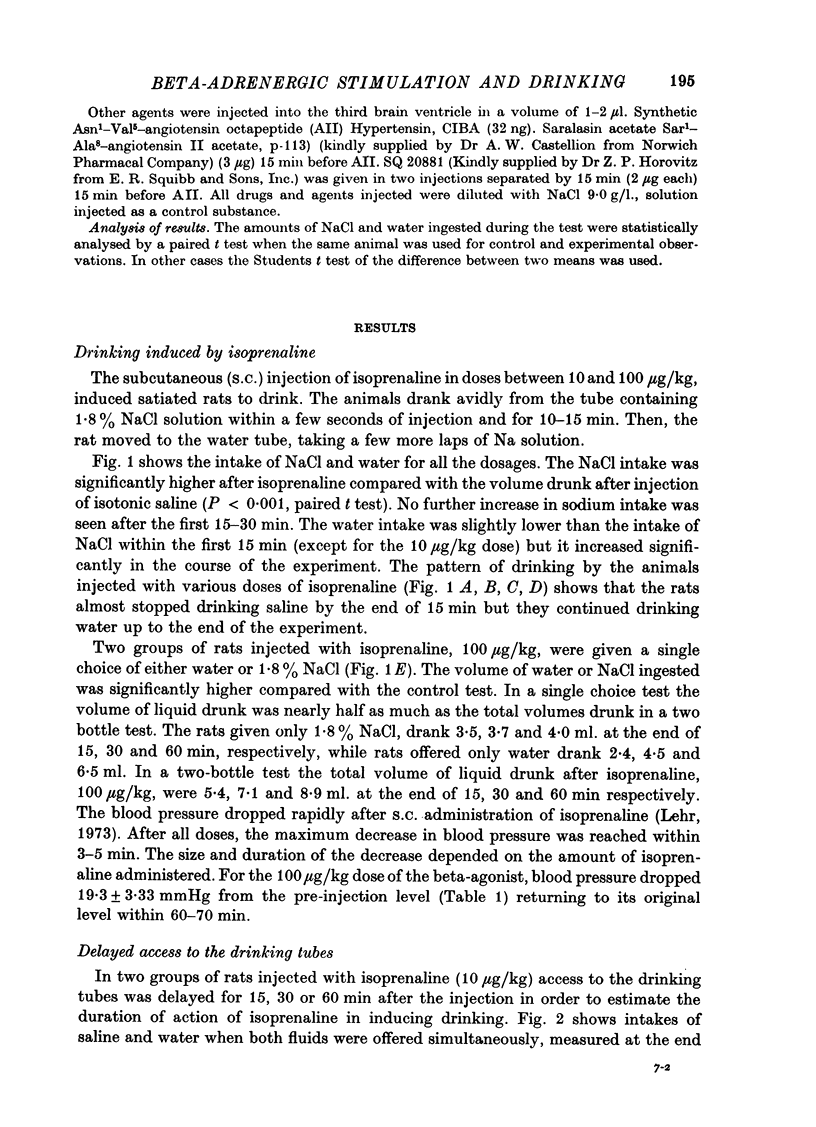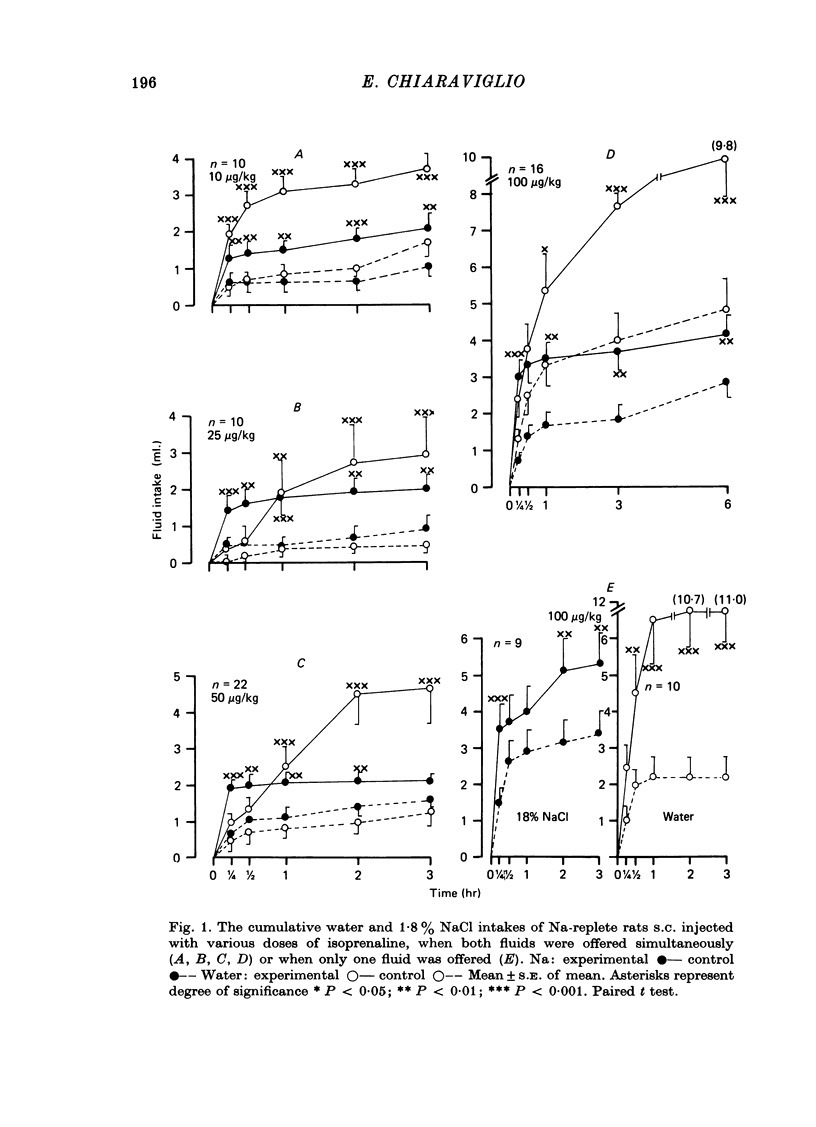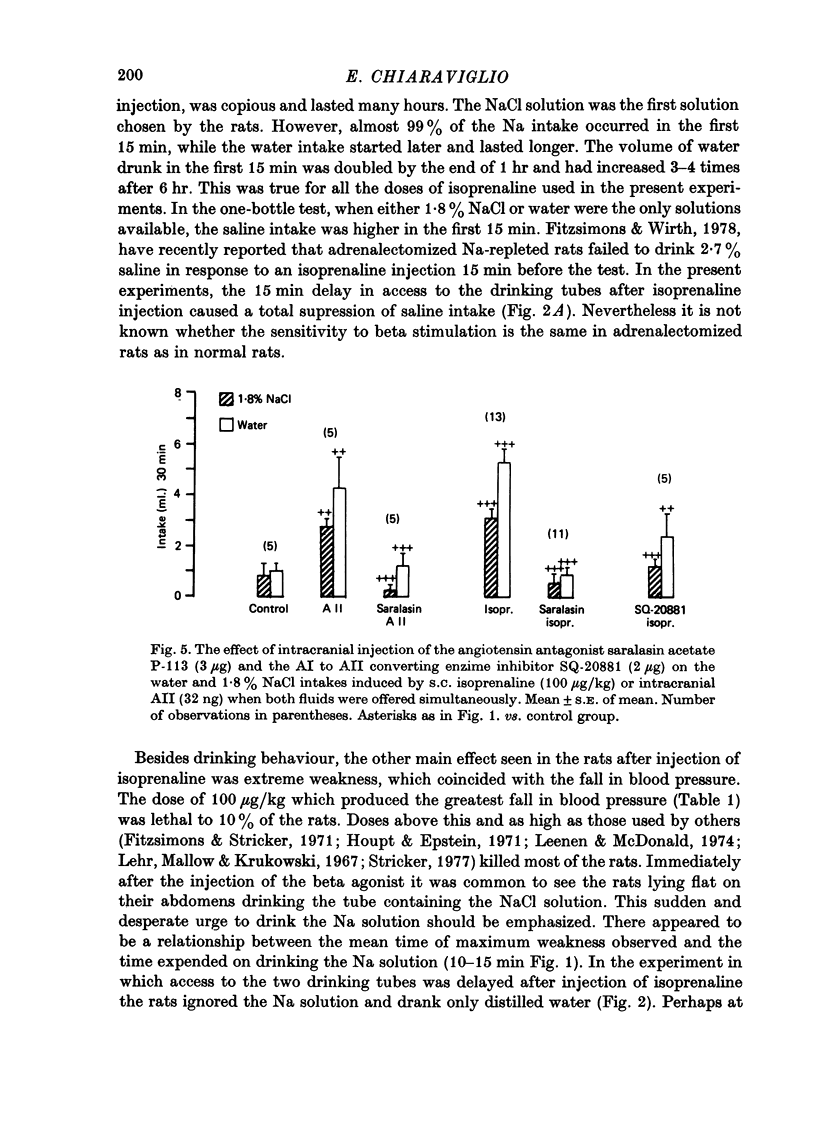Abstract
1. Isoprenaline hydrochloride injected subcutaneously in rats given a choice test of 1·8% NaCl and water, first induced saline intake which started immediately and was almost concluded in 15 min, followed by a copious water intake. When either saline or water were given in a separate test, saline intake surpassed the water intake in the first 15 min.
2. The delay of 15, 30 or 60 min after injection of isoprenaline, 100 μg/kg, before drinking was allowed, significantly reduced saline intake but did not modify the amount of water subsequently drunk.
3. Isoprenaline caused a sudden drop in arterial blood pressure, the extent and duration depending on the dose. The time of maximum drop 3-4 min after injection coincided with the time the rat drank salt.
4. Isoprenaline-induced saline drinking was significantly reduced after bilateral nephrectomy but water intake was unaffected.
5. The beta-adrenoceptor blocking agent, propranolol, inhibited isoprenaline-induced NaCl and water intake, while the alpha-adrenoceptor antagonist phenoxybenzamine abolished isoprenaline-induced NaCl intake and enhanced water intake.
6. Saralasin acetate (P-113), a competitive inhibitor of angiotensin II, given into the third brain ventricle, prevented the isoprenaline-induced NaCl and water intake as well as angiotensin II-induced drinking. The angiotensin converting enzyme inhibitor SQ-20881 reduced the isoprenaline-induced NaCl and water intake.
7. In conclusion, hypotension might be a component of salt drinking evoked by isoprenaline although the dipsogenic action of beta-stimulation is mainly due to endogenous renin-angiotensin activation.
Full text
PDF









Selected References
These references are in PubMed. This may not be the complete list of references from this article.
- Abdelaal A. E., Mercer P. F., Mogenson G. J. Plasma angiotensin II levels and water intake following beta-adrenergic stimulation, hypovolemia, cellular dehydration and water deprivation. Pharmacol Biochem Behav. 1976 Mar;4(3):317–321. doi: 10.1016/0091-3057(76)90248-3. [DOI] [PubMed] [Google Scholar]
- Chiaraviglio E. Angiotensin-norepinephrine interaction on sodium intake. Behav Biol. 1976 Jul;17(3):411–416. doi: 10.1016/s0091-6773(76)90779-3. [DOI] [PubMed] [Google Scholar]
- Chiaraviglio E. Effect of renin-angiotensin system on sodium intake. J Physiol. 1976 Feb;255(1):57–66. doi: 10.1113/jphysiol.1976.sp011269. [DOI] [PMC free article] [PubMed] [Google Scholar]
- Chiaraviglio E., Taleisnik S. Water and salt intake induced by hypothalamic implants of cholinergic and adrenergic agents. Am J Physiol. 1969 Jun;216(6):1418–1422. doi: 10.1152/ajplegacy.1969.216.6.1418. [DOI] [PubMed] [Google Scholar]
- Epstein A. N., Fitzsimons J. T., Rolls B. J. Drinking induced by injection of angiotensin into the rain of the rat. J Physiol. 1970 Sep;210(2):457–474. doi: 10.1113/jphysiol.1970.sp009220. [DOI] [PMC free article] [PubMed] [Google Scholar]
- Fitzsimons J. T., Simons B. J. The effect on drinking in the rat of intravenous infusion of angiotensin, given alone or in combination with other stimuli of thirst. J Physiol. 1969 Jul;203(1):45–57. doi: 10.1113/jphysiol.1969.sp008848. [DOI] [PMC free article] [PubMed] [Google Scholar]
- Fitzsimons J. T., Stricker E. M. Sodium appetite and the renin-angiotensin system. Nat New Biol. 1971 May 12;231(19):58–60. [PubMed] [Google Scholar]
- Fitzsimons J. T. The role of a renal thirst factor in drinking induced by extracellular stimuli. J Physiol. 1969 Apr;201(2):349–368. doi: 10.1113/jphysiol.1969.sp008760. [DOI] [PMC free article] [PubMed] [Google Scholar]
- Fitzsimons J. T., Wirth J. B. The renin-angiotensin system and sodium appetite. J Physiol. 1978 Jan;274:63–80. doi: 10.1113/jphysiol.1978.sp012134. [DOI] [PMC free article] [PubMed] [Google Scholar]
- Gutman Y., Benzakein F., Livneh P. Polydipsia induced by isoprenaline and by lithium: relation to kidneys and renin. Eur J Pharmacol. 1971 Nov-Dec;16(3):380–384. doi: 10.1016/0014-2999(71)90042-2. [DOI] [PubMed] [Google Scholar]
- Houpt K. A., Epstein A. N. The complete dependence of beta-adrenergic drinking on the renal dipsogen. Physiol Behav. 1971 Dec;7(6):897–902. doi: 10.1016/0031-9384(71)90061-8. [DOI] [PubMed] [Google Scholar]
- Leenen F. H., McDonald R. H., Jr Effect of isoproterenol on blood pressure, plasma renin activity, and water intake in rats. Eur J Pharmacol. 1974 May;26(2):129–135. doi: 10.1016/0014-2999(74)90218-0. [DOI] [PubMed] [Google Scholar]
- Lehr D., Mallow J., Krukowski M. Copious drinking and simultaneous inhibition of urine flow elicited by beta-adrenergic stimulation and contrary effect of alpha-adrenergic stimulation. J Pharmacol Exp Ther. 1967 Oct;158(1):150–163. [PubMed] [Google Scholar]
- Meyer D. K., Peskar B., Tauchmann U., Hertting G. Potentiation and abolition of the increase in plasma renin activity seen after hypotensive drugs in rats. Eur J Pharmacol. 1971 Nov-Dec;16(3):278–282. doi: 10.1016/0014-2999(71)90028-8. [DOI] [PubMed] [Google Scholar]
- Peskar B., Meyer D. K., Tauchmann U., Hertting G. Influence of isoproterenol, hydralazine and phentolamine on the renin activity of plasma and renal cortex of rats. Eur J Pharmacol. 1970 Mar;9(3):394–396. doi: 10.1016/0014-2999(70)90243-8. [DOI] [PubMed] [Google Scholar]
- Stricker E. M. The renin-angiotensin system and thirst: a reevaluation. II. Drinking elicited in rats by caval ligation or isoproterenol. J Comp Physiol Psychol. 1977 Dec;91(6):1220–1231. doi: 10.1037/h0078072. [DOI] [PubMed] [Google Scholar]
- Tang M., Falk J. L. Sar1-Ala8 angiotensin II blocks renin-angiotensin but not beta-adrenergic dipsogenesis. Pharmacol Biochem Behav. 1974 May;2(3):401–408. doi: 10.1016/0091-3057(74)90087-2. [DOI] [PubMed] [Google Scholar]


